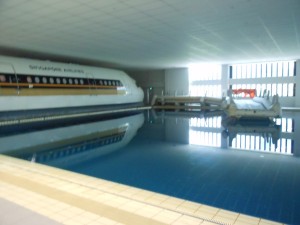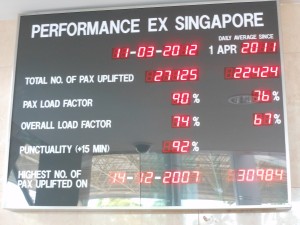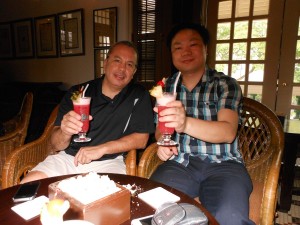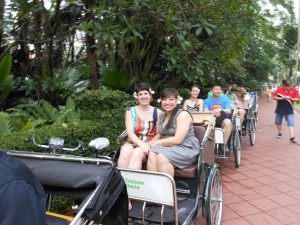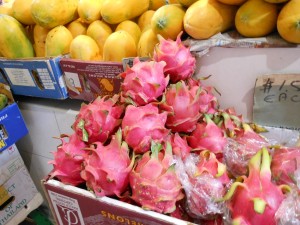Adventures in Singapore
Sara Jones, TMMBA Class of 2012 & Assistant Director
The study tour flew by and I haven’t had a chance to blog. It was a packed trip, but amazing. Here’s a rundown of my time in Singapore. I’ll share more about Beijing in the next post.
Our guide taught us about the local people, culture, and current affairs.
Singaporeans are primarily of Malay, Indian, and Chinese descent. This creates a melting pot of food, traditions, and customs. On non-company visit days we toured Little India, the Arab Quarter, Chinatown, and the downtown area. Lin was a character and taught us about the local culture through jokes and stories while we were on our bus. Here are a few things that stood out to me:
- The 5 C’s of Singapore: cash, car, credit card, condominium, and country club. In the Singaporean culture there is a bit of an obsession with material goods. Lin shared that this is due to a cultural importance on impressing others. For example, cars in Singapore are extremely expensive to own, but this is a symbol of status and so many families still own a car.
- The national bird of Singapore is the crane. Everywhere we drove there were cranes working. Singapore has a huge port that is the mainstay of their economy. We learned that Singapore doesn’t produce much raw material or food and is really dependent on trade. There was also a lot of construction going on all over town.
- Compulsory savings accounts & housing. Housing costs were crazy in Singapore! We learned that many local homeowners purchase through a public housing program and pay for it out of a compulsory savings account, the Central Provident Fund (CPF). According to our guide, employees have to put 20% of their salary into the fund and employers pay in 16%. Employees may use a portion of the CPF savings to purchase a home through the public housing program. The remaining amount stays in the fund for healthcare and retirement costs.
- Hawker Centres: I loved the food courts. There were lots of options for dining in Singapore. My favorite was to just head to a local hawker center. These look and feel like food courts, but the have an awesome selection of food and are much better quality than the stereotypical food court in the U.S. Some were outdoor stalls, others were in the basement of malls. All were delicious!
The company visits.
While in Singapore we visited Johnson & Johnson, Singapore Airlines, A*Star, and GE Power & Water.
At Johnson & Johnson we learned about regulatory affairs for medical devices in Singapore and Asia. J&J setup in Singapore because it’s a hub for access and transportation to Asia and had very attractive tax incentives for international companies. However, medical device is one of the scariest areas for US companies in Asia due to JV and regulatory compliance issues. J&J participates in the Asia Harmonization Working Party, which is a primary platform for exchanging information about medical device regulations. One thing that stuck out to me from their presentation is the complexity of what they are dealing with in Asia. For example, before a group of countries can agree on regulations for a device, it first needs to agree that a specific item is considered a medical device.
During our visit to Singapore Airlines we had a presentation on the airline, it’s competitive landscape, and difficulties facing the industry as well as a tour of their flight-crew training center. The presentation was great, but the tour of the training facility was even more fun. The selection process at Singapore Airlines was likened to American Idol. They hold 6 walk-in crew recruitment sessions a year. Applicants have 1 minute to pitch themselves during rounds of panel interviews. After they narrow it down and select the hires, the new crew head to training. The training program is twice as long as the industry average. It was really interesting to see the training center and how flight attendants are trained– from understanding the airline’s philosophy on customer service to preparing for emergencies.
A*STAR is the Agency for Science, Technology, & Research. We spoke with the Managing Director, Professor Low Teck Seng. A*Star works to promote research and talent that will develop Singapore into a knowledge-based economy. They have 14 science and engineering research institutes and six centers located on their two campuses, called Biopolis and Fusionopolis. They have three areas of current strategic focus. These are to develop their human capital in the areas of science, engineering, and technology; increase the intellectual capital of Singapore; and promote the commercial application of science and technology in Singapore.
GE Power & Water was one of my favorite visits in Singapore. We met with Adil Dhalla, the Director of the Singapore Water Technology Center. He was an engaging presenter and it was interesting to learn about the water reclamation projects in Singapore. His center houses scientists and engineers that are working to solve global water challenges including seawater desalination and water recycling. In Singapore the Public Utility Board calls their reclaimed water NEWater. It’s potable but is mostly used for industries that require high-purity water.
Here are a few more photos from our adventures in Singapore:


